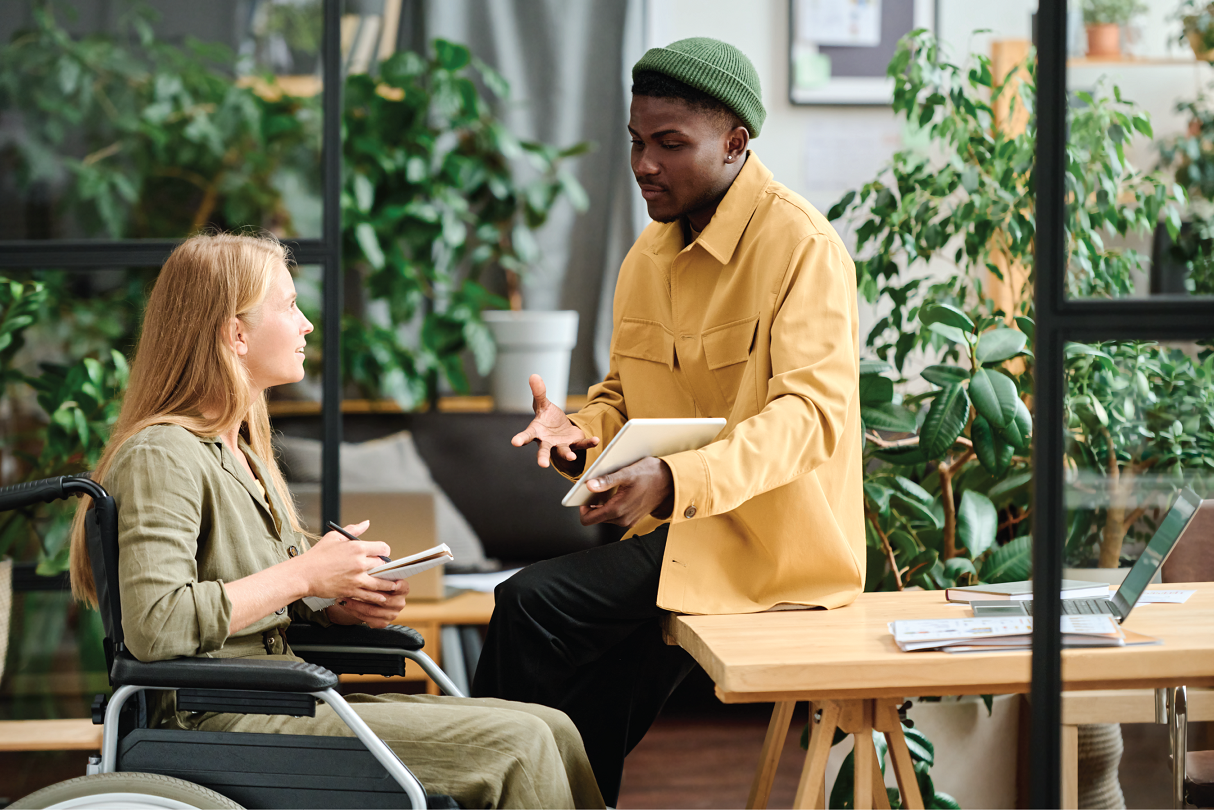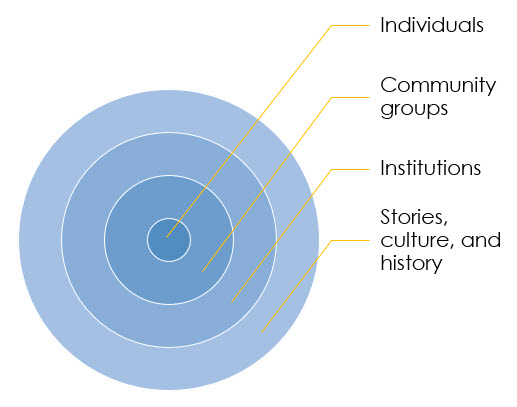Easy as ABCD: Using asset-based community development as a lens for authentic relationship-building

Building relationships with systematically excluded communities is one of the most important things your library can do to support relevant, meaningful services. In my recent Next blog post with OCLC, I wrote about how co-creation can help librarians embody our EDISJ (equity, diversity, inclusion, and social justice) values by working with our communities, rather than for or at them. The first and most foundational pillar of co-creation is building authentic relationships of trust across multiple identities and lived experiences. This article provides a focused look at one approach to starting and sustaining such relationships—asset-based community development or ABCD.
Asset-based community development (ABCD) is an approach to planning based in the recognition that all people and communities have strengths, gifts, and capacities. Its focus is on engaging and building from these strengths.
What is asset-based community development?
ABCD stands in contrast to a deficit-based perspective, which treats marginalized groups and individuals as having needs, and institutions like libraries as having resources and solutions. This type of “helping” positions those experiencing oppression as passive victims with nothing to contribute. It erases the richness of their experiences and expertise, and strips them of power and agency. Even when well-intentioned, it’s both inaccurate and deeply disrespectful—certainly no foundation for an authentic relationship. By contrast, an asset-based perspective treats all people as having the ability and desire to contribute to a collective effort. It respects those closest to an issue as powerful, insightful, and skilled experts in their own experience.
Some of the core principles of ABCD include:
- Everyone has gifts. We all have the ability and the desire to contribute.
- Everyone cares about something. We need to listen to understand the future people want to build, and what inspires them to act.
- Listening and asking are more powerful than telling. We create ideas and solutions through engaging in inclusive conversations and relationships.
- We all contribute. There’s no divide between institutions and people or between “givers” and “takers.” We all have agency, we all contribute, and we are all needed.
ABCD is neither new nor specific to libraries. Its principles were popularized in the mid-1990s, largely by the book Building Communities from the Inside Out by Kretzmann and McKnight. The approach is still highly valuable for library workers today. The impacts of acting from a belief in every person’s agency remain radically transformative.
How can libraries apply ABCD to build relationships?
Many organizations and professions based in a social service model, including libraries and librarians, may find themselves unconsciously defaulting to a deficit mindset. This directly impacts how we approach partnerships, services, and programs for individuals and organizations from systematically excluded communities.
When we believe others have needs we can fill, we tend to approach them with answers. For example, we may focus on promoting our existing resources as solutions to meet their needs. We may invite partners to play a predetermined role in a program we have already designed. Our interactions are transactional and focused on individual deliverables.
Instead, when we see others as having strengths and gifts we can learn from, we approach them with questions. We focus on asking about their knowledge, their goals, and their work. We might invite them for a conversation to learn more about them, with no specific programmatic deliverable in mind. We might ask how the library could support their existing work and goals through our services or resources. Through an ABCD lens, our interactions become transformational, based in sustained relationships.
Aspirations-focused questions can be a powerful tool. When reaching out to a potential new partner, organization, or individual, try to learn about their strengths and desires, rather than focusing on their needs or proposing solutions. You might consider questions like:
- What are your dreams, goals, or aspirations?
- What are you passionate about?
- What work are you already doing that excites or inspires you?
- What unique strengths or perspectives do you bring to that work?
- What resources or support do you most want in your work?
- Who else do you think I should reach out to?
Many organizations focused on community engagement can provide even more examples of questions, such as the "Turning Outward” resources from ALA’s Libraries Transforming Communities initiative.
Get started with asset mapping
Who should you reach out to for these aspirations-based conversations? With so many people and communities in our service areas and a limited amount of staff time, knowing where to start can feel challenging. It may be easy to give our time and attention to the people with the loudest voices—those already asking the library for partnerships, programs, and resources. To take an equity lens, however, it’s important to reach out intentionally and proactively to systematically excluded communities that may not approach us. This is where an asset map can be helpful.
An asset map is a tool to help understand the interconnected network of leaders and strengths in a community. You can create one to help you identify and connect with conversation partners. There are many ways to create an asset map, but this simple template is a good starting point. It prompts you to think about four interrelated layers of the community you want to understand and reach.
The layers include:

- Individuals. Who are the trusted leaders in this community? Think of both formal leaders (elected officials, directors of key organizations) and informal ones (elders, volunteers, people with high degrees of trust and connection in the community).
- Community groups. These are ways people come together socially or voluntarily. Examples might include neighborhood groups, service clubs, parent groups, or even regular gatherings at parks or community centers (or libraries!) Some may be discoverable only by word of mouth.
- Institutions. This category includes established organizations like businesses, nonprofits, and cultural organizations. Institutions often have paid staff, an online presence, and/or a physical location like an office. Because of their visibility, this is the easiest layer to start with if you have few or no existing relationships in a community.
- Stories, culture, and history. What are the narratives a community tells about itself? What does it see as the cultural and historical touchstones that bring members together? What stories help shape their shared identity and make them proud to be part of the community?
This simple framing can provide a systematic way to think through the people, groups, and relationships between them that make up the community’s ecosystem. Try writing down a few names in each circle and note where you can easily find people, and where you might need to learn more. As you reach out and get to know people, you can visualize their relationships by drawing lines between people and organizations with strong connections. Asset maps are most useful when they are living documents, so keep updating yours as you build more relationships in a community.
Relationships first. What next?
A relationship alone doesn’t tell you what to do together or how to turn your ideas into viable services. Many good relationships never result in a shared project. For libraries looking to co-design programs and services, how do you move from relationships to focused partnerships?
Strong relationships are the foundation for any kind of shared work. Projects start and end, but relationships can endure and grow. Library staff and partners need to focus first on building trust and mutual understanding through respect for each other’s strengths and gifts.
The next articles and webinar in this series will help you develop the processes and skills you need to move forward together.
And for a deeper dive into relationship-building, view my recent webinar in partnership with OCLC WebJunction. It features a rich conversation with practitioners well-versed on building authentic relationships with underserved communities.
Dr. Audrey Barbakoff is the CEO of Co/Lab Capacity, which provides community-centered consulting and training for libraries and social good organizations.
Explore more community engagement resources
This article is part of a collection of resources and webinars created with Dr. Audrey Barbakoff on community engagement. Explore the full collection, including articles and webinar recordings, plus learner guides and related resources:
- Co-create authentically with your community (OCLC Next blog post): Explore co-creation as an effective diversity, equity, and inclusion strategy and learn three important elements of its approach.
- Align library services with community aspirations (article): Learn how and when to transform relationships into community partnerships.
- Building authentic relationships with underserved communities (webinar recording): Learn how to develop a plan for identifying, reaching, and building relationships with underserved communities.
- Co-creating library services for transformative impact (webinar recording): Learn about the fundamentals of co-design and explore how to apply them in your library for wildly creative and deeply impactful programs and services.
Community engagement
Where do you go for inspiration? Invigorate your community engagement efforts with advice from library leaders.
